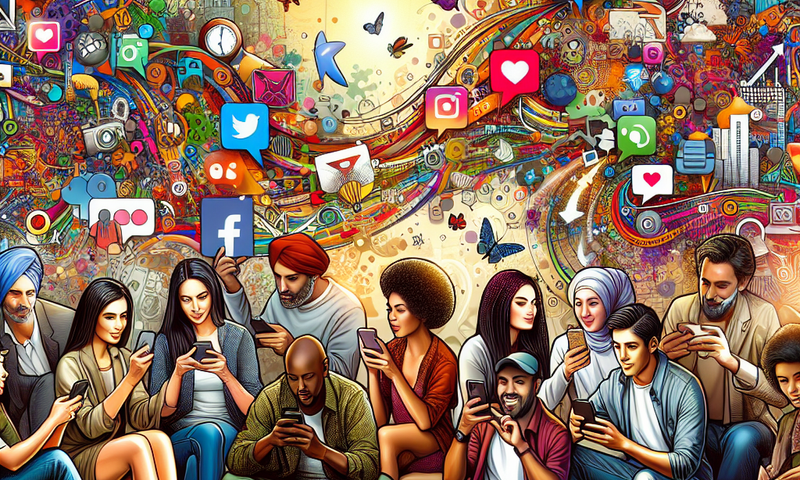
The Optimal Exploitation of E-commerce and Influencers: A Guide to Success
3 December، 2023
Influencer Marketing B2B: Harnessing the Power of Industry Thought Leaders for Effective Business Growth
6 December، 2023The Rise of Fake Influencers: Unmasking the Micro Influencer Scam

Title: The Rise of Fake Influencers: Unmasking the Micro Influencer Scam
SEO Meta-Description: Learn about the rise of fake influencers and the micro influencer scam. Discover the percentage of influencers that are fake and the problems associated with micro-influencers. Find out if the f74 trend is real or fake and whether it actually works. Stay informed about the latest trends and avoid falling victim to influencer fraud.
Introduction:
In recent years, the world of social media has witnessed the rapid rise of influencer marketing. Brands have turned to influencers as a way to reach their target audiences and build authentic connections. However, this rise in creator partnerships has also given birth to a concerning issue – the rise of fake influencers. In this article, we will delve into the world of influencer fraud, unmask the micro influencer scam, and provide insights into the challenges associated with micro-influencers. We will also address the trend of f74 and determine its authenticity and effectiveness.
The Rise of Fake Influencers: Unmasking the Micro Influencer Scam
Heading 1: The Authenticity of Influencers in Question
The influencer marketing industry has faced a significant challenge in the form of fake influencers. A shocking statistic reveals that nearly 50% of Instagram influencers have engaged in fraudulently inflating their follower counts. This alarming trend highlights the need for brands to be cautious and vigilant when selecting and partnering with influencers.
Heading 2: Understanding Fake Influencers
What exactly are fake influencers, and how do they operate? Fake influencers are individuals who falsely boost their follower count, engagement levels, and overall popularity to attract brand collaborations. They may resort to purchasing fake followers, manipulating comments, likes, and views, or participating in engagement pods.
Heading 3: The Impact of Fake Influencers on Brands
Partnering with a fake influencer can have detrimental effects on a brand's reputation. It not only risks damaging the brand's image but also reduces the chances of repeat business. Therefore, it is crucial for brands to detect and avoid fake influencers to ensure authentic connections with their target audience.
Heading 4: Identifying Fake Influencers
Brands can take proactive steps to identify fake influencers and protect themselves from falling victim to influencer fraud. Analyzing engagement metrics, reviewing followers and comments, and utilizing auditing tools are effective strategies to spot suspicious accounts.
The Pros and Cons of Micro-Influencers
Heading 5: The Advantages of Micro-Influencers
Micro-influencers offer several benefits that make them an attractive option for brands. One of the major advantages is their authenticity. Micro-influencers are seen as more genuine and trustworthy compared to larger influencers or celebrities. They have a closer connection with their followers and are perceived as real people who share honest opinions and experiences. This authenticity builds trust and credibility among their audience.
Heading 6: Enhanced Audience Engagement
Micro-influencers tend to have a highly engaged and loyal following. Due to their smaller follower count, they can interact more personally with their audience, fostering a stronger sense of community. This increased engagement results in higher interaction rates, which are valuable for brand campaigns.
Heading 7: Cost-Effectiveness
Working with micro-influencers often proves to be cost-effective for brands. Unlike larger influencers, micro-influencers typically charge lower fees or are open to collaborations in exchange for free products or services. This makes them a budget-friendly option, especially for brands with limited marketing resources.
Heading 8: Niche Market Targeting
One of the major advantages of micro-influencers is their expertise in specific topics or industries. They have a dedicated following that shares similar interests and values. Partnering with micro-influencers allows brands to target their ideal audience precisely and ensure that their message reaches the right people.
Heading 9: Challenges of Micro-Influencers
Although micro-influencers offer numerous advantages, there are challenges associated with working with them. One such challenge is the time and effort required for outreach and relationship building. Micro-influencers may receive numerous collaboration requests, which can make it challenging for brands to stand out and establish a fruitful partnership. Additionally, the reach of micro-influencers may be limited compared to larger, more established influencers.
Is the f74 Trend Real or Fake? Does It Work?
Heading 10: An Introduction to the f74 Trend
The f74 trend has gained attention in the world of social media marketing. However, its authenticity and effectiveness have been questioned. Let's explore whether the f74 trend is real or just another fad.
Heading 11: Unraveling the f74 Trend
Despite the buzz surrounding the f74 trend, there is limited evidence to support its validity. It is essential to approach this trend with caution and critically evaluate its claims before incorporating it into marketing strategies.
Heading 12: Debunking the f74 Trend
Numerous reports suggest that the f74 trend is more of a hoax than a legitimate marketing strategy. It is important to distinguish between real trends that bring value and potential scams that may harm a brand's reputation.
Heading 13: The Effectiveness of the f74 Trend
The effectiveness of the f74 trend remains questionable. It is advisable for brands to rely on well-established marketing techniques and thoroughly evaluate any new trends before integrating them into their campaigns.
Heading 14: How to Protect Your Brand
To protect your brand from falling into the trap of fake influencers and ineffective trends like the f74 trend, it is essential to conduct thorough research, analyze performance metrics, and collaborate with influencers who align with your brand values and audience.
Heading 15: Conclusion and Future Outlook
In conclusion, the rise of fake influencers presents a significant challenge for brands in the influencer marketing landscape. However, with proper research, vigilant analysis of prospective influencers, and genuine audience engagement, brands can minimize the risks associated with influencer fraud. The micro-influencer industry continues to thrive due to its numerous advantages, including authenticity, enhanced engagement, cost-effectiveness, and niche market targeting. While the f74 trend may capture attention in the short term, it should be approached with caution. Focus on proven marketing strategies, continuously monitor industry trends, and adapt accordingly to stay ahead in the ever-evolving world of influencer marketing.
FAQs:
-
What is an influencer scam?
Influencer scams refer to fraudulent practices employed by individuals to manipulate their influence and deceive brands into partnerships for personal gain. These scams often involve inflating follower counts, engagement levels, and overall popularity. -
What percentage of influencers are fake?
According to statistics, nearly 50% of Instagram influencers have engaged in fraudulently inflating their follower counts. This highlights the prevalence of fake influencers in the industry. -
What are fake influencers?
Fake influencers are individuals who falsely boost their follower count, engagement levels, and overall popularity to attract brand collaborations. They may resort to purchasing fake followers, manipulating comments, likes, and views, or participating in engagement pods. -
What are the problems with micro-influencers?
While micro-influencers offer several advantages, there are challenges associated with working with them. These challenges include the time and effort required for outreach and relationship building, as well as potential limitations in terms of reach compared to larger influencers. -
Is the f74 trend real or fake? Does it work?
The f74 trend has generated buzz in the social media marketing world, but its authenticity and effectiveness remain questionable. It is crucial for brands to critically evaluate and test new trends before incorporating them into their marketing strategies.
Keywords: influencer scam, fake influencers, micro-influencers, problems, fake influencers exposed, f74 trend, real or fake, does it work



